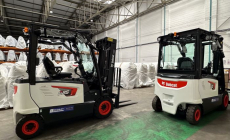-
QUECLINK NAMED LEADING TELEMATICS HARDWARE PROVIDER AFTER YEAR OF GROWTH AND INNOVATION - January 9, 2026
-
Women Leading the Way in the UK Material Handling Industry - December 12, 2025
-
LiftEx 2025 live from Liverpool - December 11, 2025
-
DATA ANALYSIS – THE FOUNDATION OF EVERY PEAK SEASON - December 5, 2025
-
Creative education specialists Creative Hut give 3PL full marks for onboarding excellence - December 5, 2025
-
Unlimited Industries raises $12M to build the AI construction company that will power America’s future - December 4, 2025
-
Scottish Leather Group gets full-support solution from Rushlift - December 4, 2025
-
Etaily lands strategic investment from Japan’s SMBC – bringing total funding to $24M for Social Commerce enablement platform - December 4, 2025
-
Winners lift their LEEA Awards and raise the industry - December 4, 2025
-
Prism eLogistics and Brand Angels Partnership Gives Brands the Full Package - December 3, 2025
Order picking is one of the most important activities in a warehouse operation and has traditionally been highly labour intensive. If a warehouse is not efficiently laid out, if stocks are not easily located or retrieved, and if the order fulfilment cycle is particularly demanding to complete, picking can easily become a chaotic process. It needs to be carefully managed and the right investments made to ensure it is optimally efficient. This article explains how to evaluate different technology driven picking systems, to identify which one is most suitable to your type of warehouse.
Avoid costs of picking getting out of control
Given its significant impact on costs, optimising order picking is essential for improving warehouse efficiency and for meeting key performance indicators (KPIs) like on-time and in-full (OTIF) delivery targets. When the pick process is finely tuned, it reduces errors, increases throughput speeds and enhances overall productivity, leading to many cost savings and improved customer satisfaction levels.
Not surprisingly, many companies invest large amounts of resources into their picking activities. For instance, in some warehouses, between 50% to 75% of the total warehouse operating expenses are allocated to picking tasks. This high cost can be the result of having to employ large numbers of operatives – especially during busy periods – and the cost of time wasted when pickers are travelling between warehouse locations. Costs can also be generated by investing in technology to automate as many picking tasks as possible, although this will continue to deliver a return on investment, whereas the cost of labour is always a one off, sunk cost.
Integrate with a WMS whatever picking system you use
Regardless of the order picking system you choose, by investing in a warehouse management system WMS, you can introduce a seamless layer of automated operational management into your picking processes. This can be achieved if your WMS is fully integrated with whatever picking system your business will benefit most from.
When the WMS is fully integrated with an order picking system, you can reap the benefits of:
- Automated task allocation, because the WMS can dynamically allocate tasks to different pickers based on workload levels, skills levels and real-time location data showing proximity to the item, ensuring optimal use of resources;
- Real-time inventory updates to avoid issues with out of stocks and overstocks, reducing errors and enhancing inventory accuracy. For instance, by requesting automated checks to confirm that the correct items and quantities are picked, thereby minimising errors;
- Optimised efficiency and productivity because a fully automated picking operation driven through a WMS will streamline workflows, reducing travel time and improving efficiency. For instance, order picks can be prioritised based on delivery schedules and customer importance, ensuring timely dispatch to meet OTIF targets.
How to evaluate the order picking system your business needs
Let’s explore the different types of order picking systems and the pros and cons of each.
Barcode Scanning. This is a picking system whereby pickers use handheld scanners to scan item barcodes in the warehouse, ensuring accuracy and real-time inventory updates. It is flexible and easy to implement and is suitable for many types and sizes of warehouse. Warehouse barcode picking is a good option for bulk picking, whereby large quantities of single items are collected in one go. For example, barcode scanning works well in beverage warehouses fulfilling large orders for supermarkets.
Voice Picking. This is a technologically advanced picking system whereby the pickers receive instructions about what to pick and where to find the items through headsets. Voice picking offers many advantages including hands-free operation and reduced errors because the operative has to perform an item check to move onto the next task. It is very effective in large, complex warehouses and environments where the types of stock sold varies significantly or where the item shelf life is short because it is very efficient.
Pick to Light exists in many forms. It can utilise coloured lights and displays to guide pickers to the correct items for an order, enhancing working speeds and accuracy. These pick to light methods are well suited to e-commerce environments using wave picking, where multiple orders are picked simultaneously, and in environments requiring quick, accurate order preparation. It is ideal for high-volume, fast-paced environments and for warehouses where the types of products being sold does not vary too frequently with seasonality. It is also an ideal system in a warehouse where many operatives do not speak English as a first language because workers are guided to the right locations. Pick to light systems have been shown to increase picking speeds, reduce errors and significantly improve productivity, making this an ideal choice for small, high-turnover items.
Paper Sheets. Strictly speaking, paper-based picking list sheets is a ‘process’ although it is rather inefficient and outdated for the majority of warehouses today. It is a traditional method and tends to be found in small operations with low order volumes and very limited budgets.
Efficient order picking is always the goal in any business, and a WMS will provide previously unseen levels of visibility to the process. This is absolutely crucial for warehouse managers to get right if they are aiming to meet and exceed KPIs – like shipping orders on time and in full. There are various order picking processes and technologies to choose from and each will cater to different warehouse scenarios, such as bulk picking, e-commerce picking and the handling of heavy goods.
Whatever picking system your business decides to use, the most important aspect is to properly integrate with a WMS. This will create a unified platform that provides comprehensive visibility into the entire operation, helping warehouse managers make informed decisions and quickly address any issues that may arise.

































